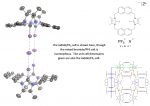David Watkin was presented with his ACA Fankuchen Award at the ACA 2011 meeting. He gave a plenary lecture entitled “X-ray Crystallography. Is the Gold Standard becoming Tarnished?”

CRYSTALS v14.23c installer is available to download for the Windows platfom.
[Update – patched version 1423c released 27 May, fixes format problem with tiny weights in FCF, CIF input bug]
Selected highlights:
- Added bond colouring to indicate either element type, or disordered part
- Improved robustness of weighting scheme 17 (Shelx weights)
- Output observation weights in

Presented by:┬Ā Matthew Tatton & Paul Winship
Research Leader:┬Ā Prof. Timothy J. Donohoe
Published:┬Ā┬ĀAngewandte Chemie International Edition
This is the final isolated intermediate in the synthesis of Neodysiherbaine A;┬Ā crystals were very small, so data were collected on I19 at Diamond.┬Ā The natural product is an excitatory amino acid isolated from the Dysidea herbacea … Read the rest
The BCA Spring Meeting was held at the University of Keele in Staffordshire.┬Ā Contributions from Chem. Cryst. included:
Richard I. Cooper, Amber L. Thompson & David J. Watkin
Standard Uncertainties and Experimental Design (Poster)
Amber L. Thompson & David J. Watkin
“UnpublishableŌĆØ Data:┬Ā Does My R-factor Look Big in This? (Poster)
David Watkin
What’s … Read the rest

The results have just been announced for the latest round of applications to the John Fell Oxford University Research Fund.┬Ā Our proposal for funding for a temperature controlled Peltier stage microscope with polarizing filters for the study of solid-state phase transitions in crystalline materials was successful.┬Ā Polarized light allows the ready detection of discontinuous changes … Read the rest

Presented by: Nicholas G. White & Dr. Fabiola Zapata
Research Leader: Prof. Paul D. Beer
Published: Journal of the American Chemical Society
Both the mixed bromide/PF6 and mixed iodide/PF6 salt of this bis-iodoimidazolium macrocycle crystallize in the unusual cubic spacegroup I m -3 (there are currently only six organic structures in this spacegroup … Read the rest

Not content with showing off the eye-catching brilliance of her new diamond engagement ring, final year Inorganic Chemistry student Rowena Scott wanted to reveal the beautiful symmetry of its atomic structure. She recorded an X-ray diffraction pattern from the diamond using one of the Chemistry DepartmentŌĆÖs new state of the art, SuperNova dual source XŌĆæray … Read the rest

CrystEngComm (2011), 13(8) 2923-2929. ┬Ā┬Ā [ doi:10.1039/c0ce00709a ]
A series of racemic or stereochemically labile chiral borate anions based on the 2,20-biphenol motif was
investigated. All borates were homochiral in the solid state, although in some cases the heterochiral
diastereomers were computed to be thermodynamically preferred (DFT). The crystallographic
preference for the homochiral diastereomer was … Read the rest

Presented by:┬Ā Dr. Andrew D. Schwarz & Liban M. A. Saleh
Research Leader:┬Ā Prof. Philip Mountford & Prof. Simon Aldridge
Published:┬Ā Journal of the American Chemical Society
Transition-metal boryl compounds (L)M(BX2)x, containing 2ŌĆæcenter, 2ŌĆæelectron ŽāŌĆæbonds have been a topic of outstanding interest due to pivotal roles … Read the rest

Presented by:┬Ā Nicholas H. Evans & Christopher J. Serpell
Research Leader:┬Ā Prof. Paul D. Beer
Published: Angewandte Chemie International Edition
Catenanes and rotaxanes are highly attractive targets for the supramolecular chemist due to their potential uses as molecular machines or as selective hosts for ionic and molecular guests. This molecule was synthesised via chloride anion … Read the rest